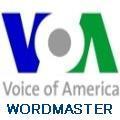AA: I'm Avi Arditti with Rosanne Skirble, and this week on WORDMASTER: More advice about giving oral presentations. Last week English teacher Nina Weinstein talked about ways to get mentally prepared. The most important part of any speech is you, Nina says. But for the audience, the focus is not you but the information they are there to get. And one way for English language learners to make themselves more understandable is to slow down.
NINA WEINSTEIN: "You can't make your pronunciation perfect if it's not there yet. You need to take pronunciation classes or whatever, but you still have to give your speech. And so one of the most effective ways to be understood is to cut your speed in half. Whenever you're speaking to a group you have to slow down anyway, even if you're a native speaker. So that's one technique. "Another technique is to open your mouth wider. A lot of times students feel that they're pronouncing the 'th' sound or the 'w' sound or the 'b' sound fully, but in actuality if their mouths are not open wide, then maybe thirty percent of the sound is being trapped. And so just doing those two things makes it easier for the audience to understand you no matter what level you are." RS: "So how would you practice doing these skills? Basically what we've talked about is the end game, of actually making a presentation. How do you get there? How do you practice -- can you divide this up into bits?" AA: "Do you write out the speech word for word and try to memorize it?" NINA WEINSTEIN: "No, no, I don't encourage my students to do that, and none of the places that I've taught have encouraged that. If you write it out word for word, then what you're ultimately going to do is memorize it, and then you're reading. You just memorize something, and you're kind of giving that as if you're reading it. No, I have my students put it on three-by-five cards and just put lines as if they're outlining it, just put things that will help them with the sequence of it, so they don't forget something that they want to say. "As far as the actual practicing of it, they practice in front of a mirror, we practice in class. But one of the things that they should do that I think is really effective is to have someone videotape them. Because one of the issues about giving a speech is controlling your body language.
"You don't want to stand like a statue, but on the other hand you don't want nervous gestures. I had a student who played with his hair the whole time, so that becomes really distracting and it focuses the audience's attention on the fact that he's nervous. "So if you videotape, you're going to see something like that. Or sometimes students will kind of sway back and forth a little bit or maybe they're holding the cards in their hands and they're tapping on them with their index finger, or those kinds of things that can be caught if they videotape." AA: "And kind of look back and forth across the audience as you talk, look in front and in back? What do you tell people to do with their gaze?" NINA WEINSTEIN: "They need to make eye contact. What happens sometimes is that students will sweep the audience but they won't go all the way to each side, so the people on the ends are left out. And that's how it feels as an audience member if the speaker doesn't look at you, you feel as if you've been left out. "So you want to make sure that you're looking at everyone. You don't have to actually look at them, but you have to look in their direction, so it feels like you're looking at them. In a small group, you actually will be looking at them. But let's say that you're speaking in front of fifty people or a hundred people. You won't actually be looking at each person, but you'll be sweeping the room so that it looks like you are." RS: "And just moving on beyond the classroom, how do you think that by doing these kinds of oral presentations in the classroom can help them with their English language learning outside the classroom?" NINA WEINSTEIN: "I think it can help them in every way. First of all, they get confidence because they feel what it is to be in control of English. I think when we learn another language we know that we're not in control. We're trying our best and we're juggling so many different skill areas and so forth. But the tricks that I teach them, the slowing down, the opening your mouth wider, if there's a grammar issue and people don't understand, you can go back to the basic grammar structure of subject-verb-object -- these are all tricks and tools for them to control themselves in English. "And so I think once they feel that, my students tell me that they apply it to their other classes, whether they're giving oral presentations or they're just expressing their opinion in a class. It's basically the same skill." AA: English teacher and author Nina Weinstein comes to us from the VOA bureau in Los Angeles. Her books are available through Amazon.com. And you can find previous segments with Nina at our Web site, voanews.com/wordmaster. And that's WORDMASTER for this week. Our e-mail address is word@voanews.com. With Rosanne Skirble, I'm Avi Arditti.

